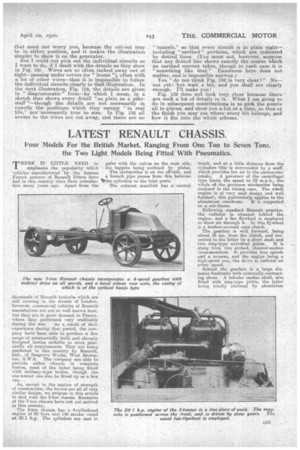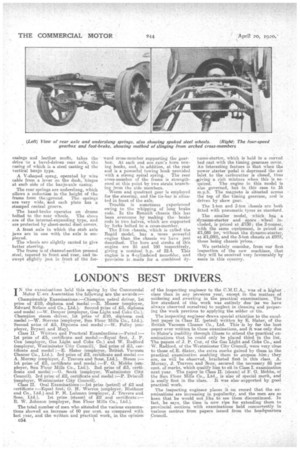LATEST RENAULT CHASSIS.
Page 23

Page 24

If you've noticed an error in this article please click here to report it so we can fix it.
Four Models For the British Market, Ranging From One Ton to Seven Tons, the Two Light Models Being Fitted With Pneumatics.
irHERE IS =LE NEED to emphasize the popularity which vehicles manufactured by the famous French concern of Renault Freres have had in this country since theirintroduction many years ago. Apart from the , thousands of Renault taxicabs which are still running in the streets of London, however, commercial vehicles of Renault manufacture are not -sa well known here, but they are in great demand in France, where they performed very creditably
during the war. As a result of their experience during that period, the company have been able to produce a fine range of substantially built and cleverly designed lorries suitable to meet practically all requirements. They are being marketed in this country by Renault, Ltd., of Seagrove Works, West Brompton, S.W.6. The company are able to provide either chassis or complete lorries, most of the latter being fitted with military-type bodies, though the one-tonner can also, lie fitted up as a box van.
As, except in the matter of strength of construction, the lorries are all-of very similar design, we propose in this article to deal with the 3-ton chassis. Examples of the 7-ton chassis have not yet arrived in this country. The 3-ton chassis has is 4-cvlindered engine of 90 bore and 140 stroke, rated at 20.1 hp. The cylinders are cast :IN pairs with the valves on the near side, the tappets being enclosed by plates. -The carburetter is on the off-side, and a branch pipe passes from this between %the cylinders to the inlet ports.
The exhaust'. manifold has a central
trunk, and at a little distance from the cylinders 'this is surrounded by a muff, which provide& hot air to the carburetter
intake. A governor of the centrifugal type limits the speed to. 12 m.p.h., the whole of the governor mechanism being enclosed in the timing case. The whole engine is of very neat design and well finished; this particularly applies to the aluminium crankcase. It is supported on a sub-frame.
Following standard Renault practice, the radiator Is, situated behind the engine, and a fan flywheel is employed to draw air through it. In this flywheel is a leather-covered cane clutch.
The gearbox is well forward, being about 18 ins, from the clutch, and connected to the latter by a short shaft and
two ring-typo universal joints. It is slung from two arched, channel-section cross-members. It provides four speeds arid a reverse, and the engine being a high-speed one, the drive is indieect on every speed.
Behind the gearbox is a large diameter footbrake with externally-contracting shoes. A tubular caa-dan shaft, also fitted with ring-type joints, the latter being totally enclosed by aluminium casings and leather muffs, takes the drive ,to a bevel-drivenrear axle, the casing of which is a steel casting of the vertical banjo type.
A V-shaped sprag, operated by wire cable from a lever on the dash, "hinges at each side of the banjo-axle casing.
The rear springs are underslung, which allows a reduction in the height of the frame from the Aground. The springs are very wide, and each plate has a stamped central groove.
The hand-brake operates on drums bolted to the rear Wheels. The shoes are of the internal-expanding type, and are protected by sheet-metal dust covers.
A front, axle in which the stub axle jaws are in one with, the axle is employed.
The Wheels are slightly canted to give better steering.
The frame is of channel-section pressed steel, tapered to front and rear, and .inswept slightly just in front of the for.'
ward cross-member supporting the gearbox At each end are ram's born towing hooks, and, in addition, at the rear end is a powerful towing hook provided with a strong spiral spring. The rear cross-member of the frame is strengthened at this point by two struts branching from the side members. • . .
Worm and quadrant gear is employed for the steering, and the tie-bar is situated in front of the axle.
Trouble is sometimes experienced owing to the whipping of long brake rods.. In the Renault chassis this has been overcome by making the brake rods in two halves, which are supported by forks bolted to a cross-member.
The 2-ton chassis, which is called the Rapid Model, has a more powerful engine than the chassis we have just described. The bore and stroke of this engine are 95 and 160 respectively, giving a nominal h.p. of 22.4. This engine is a 4-cylindered monobloc, and . provision is. made for a combined dy
narno.starter, which is held in a curved bed cast with the timing gemcase caver. An interesting feature is that when the power 'starter pedal is depressed the air inlet to the carburetter is closed, thus igiving a rich miSture when this is sequired. The engine in this model is also governed, but in this case to 16 m.p.h. The magneto is situated across the top of the timing gearease, and is driven by skew gear.
The 1-ton and 2-ton chassis are both fitted with pneumatic tyres as standard.
The smaller model, which has a dynamo-starter and spare . wheel included, is priced at £730; the 2-tonner, with the same equipment, is priced at -£1,085 (or, without the dynamo-starter, at £1,050), and the 3-ton chassis at £975, these being chassis -prices.
We certainly consider, from our first inspection of the new machines, that they will be received very favourably by users in this country,




























